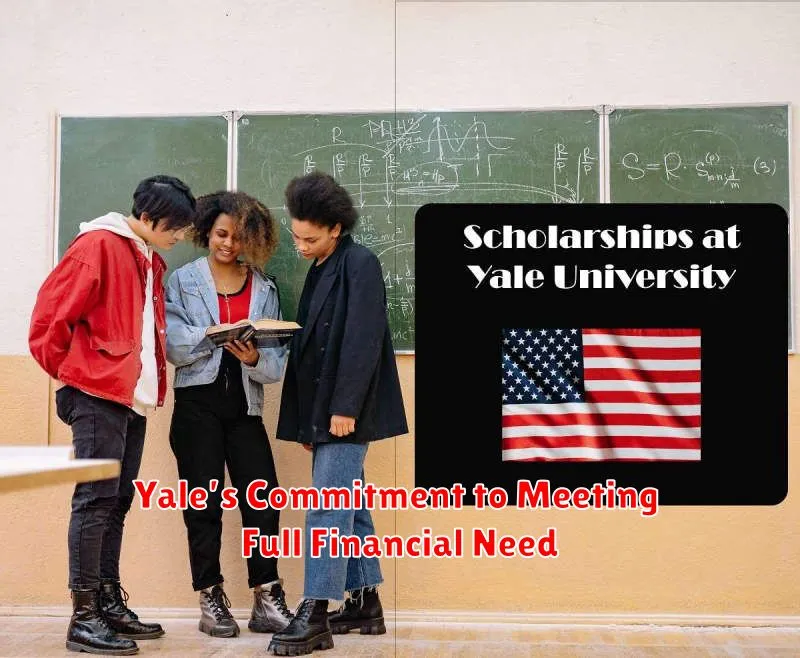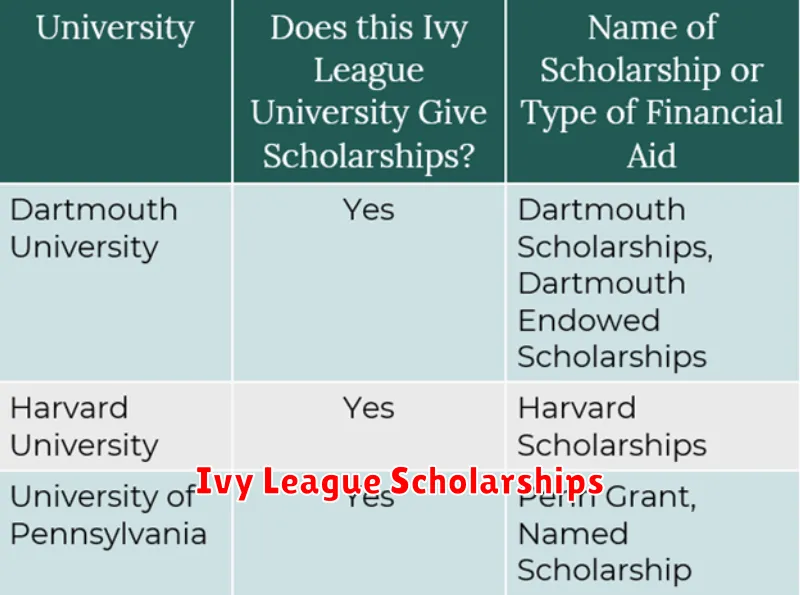The Ivy League universities, renowned for their rich history, academic excellence, and commitment to fostering talent, offer a multitude of scholarship opportunities that attract brilliant minds from across the globe. This article explores the top scholarships available at these prestigious institutions, providing an in-depth understanding of how these programs can pave the way for a transformative educational experience at some of the world’s leading universities. Whether you aspire to study at Harvard, Yale, Princeton, or any of the other illustrious Ivy League schools, learning about these scholarships could be the first step towards achieving your academic dreams. Stay with us as we delve into the specifics of these coveted financial awards that not only recognize academic prowess but also support diversity and innovation within these elite circles.
What Makes Ivy League Scholarships Unique?
The Ivy League universities are renowned not just for their academic excellence and prestigious history, but also for the distinctive nature of their scholarship offerings. Unlike many other institutions, Ivy League schools emphasize a need-blind admission policy, meaning they evaluate applications without considering the applicant’s financial situation. This approach allows them to offer generous financial aid packages based solely on demonstrated need.
The commitment to accessibility and inclusivity is a hallmark of the Ivy League scholarship model. Offering grants instead of loans ensures that students can graduate with minimal debt. Each of these universities is well-endowed, which allows them to draw from significant financial resources to support their students financially.
Moreover, scholarships often include unique opportunities beyond financial support, such as mentorship programs, internships, and access to extensive networks of alumni and professionals. This blend of financial provision and personal and professional development opportunities makes Ivy League scholarships fundamentally distinct compared to other scholarships.
Harvard Financial Aid – Generous and Need-Based
Harvard University stands out for its generous and need-based financial aid program, designed to ensure that financial constraints do not hinder talented students from receiving a world-class education. The institution prides itself on its commitment to providing opportunities for students from all economic backgrounds.
Harvard’s financial aid program covers up to 100% of demonstrated need for all students, significantly reducing the burden of tuition costs. The aid packages offered are composed of grants and work-study opportunities, meaning students can graduate without the burden of loans. The university assesses each family’s financial situation in detail to determine the level of support required, ensuring equity and accessibility.
One of the standout features of Harvard’s financial aid is its initiative to make education affordable for students from families earning less than $65,000 annually, who are not required to contribute financially to the cost of education. For families with incomes up to $150,000, the contributions are generally capped at a percentage of their income, making Harvard more accessible to a wide demographic.
Leveraging its substantial endowment, Harvard is well-positioned to support its ambitious financial aid objectives. This commitment to affordability and accessibility underscores Harvard’s dedication to fostering a diverse student body, where students can thrive based on ability rather than economic circumstance.
Yale’s Commitment to Meeting Full Financial Need

Yale University stands out among the Ivy League institutions with its unwavering commitment to supporting students’ financial needs. Recognizing the diverse backgrounds of its applicants, Yale endeavors to ensure that financial constraints do not hinder talented individuals from receiving a world-class education.
This commitment is manifested through Yale’s policy of meeting 100% of demonstrated financial need for all admitted students, irrespective of their nationality or citizenship. This approach involves a thorough and holistic assessment of each applicant’s financial situation, ensuring that every package is tailored to fit individual circumstances.
Yale’s need-based financial aid does not require any loans, which significantly reduces the potential financial burden on students and their families. Instead, the university offers comprehensive support through scholarships and grants. This support system is designed to foster a diverse academic community where students can thrive without the pressure of impending debt.
Furthermore, Yale’s approach reflects a broader objective of inclusivity and accessibility in higher education, affirming its position as a leader in providing equitable opportunities. By doing so, Yale not only invests in the individual student but also the broader societal impact that educated graduates bring.
Princeton’s No-Loan Policy Explained
Princeton University has been at the forefront of making higher education more accessible through its revolutionary No-Loan Policy. This policy ensures that students from various financial backgrounds can attend without being burdened by student loans.
Under this initiative, Princeton commits to meeting 100% of demonstrated need for all admitted students with grant aid that does not have to be repaid. By providing grants instead of loans, Princeton eliminates the financial pressure that often accompanies a college education, allowing students to focus on their studies rather than their debt.
This policy is part of Princeton’s larger effort to promote diversity and inclusion by leveling the playing field for talented students who might otherwise be deterred by the cost of an Ivy League education. The comprehensive financial aid program extends beyond tuition, covering additional expenses such as housing, meals, and personal costs.
By implementing this policy, Princeton demonstrates a strong commitment to accessibility and educational equity, ensuring that the barriers of economic hardship do not impede a student’s academic journey.
Columbia’s International Student Aid Options
Columbia University offers a range of financial aid options specifically designed for international students, acknowledging the diverse needs of its global student body. These aid packages aim to support talented students who may face financial constraints while pursuing their studies in the United States.
One of the primary forms of support is need-based financial aid. Columbia ensures that all students who qualify for this aid receive assistance that matches their demonstrated financial need, covering a portion of tuition and living expenses. The university understands the importance of making its education accessible to a broader audience.
In addition to need-based aid, Columbia provides merit-based scholarships that recognize academic excellence, leadership potential, and exceptional achievements. These scholarships are highly competitive, highlighting Columbia’s commitment to attracting top talent globally.
It’s important to note that while these aid options are generous, applicants must be diligent in their preparation and submission of required documents. Application processes typically entail comprehensive assessments of one’s financial situation and academic credentials.
Overall, Columbia’s aid options reflect its dedication to fostering an inclusive academic environment, ensuring that outstanding students from around the world have the opportunity to thrive at one of the world’s leading universities.
Tips for Getting Into an Ivy League School
Securing a spot in an Ivy League school requires a combination of academic excellence, extracurricular involvement, and a strategic approach to your application. Here are some essential tips to help you navigate the process.
First and foremost, focus on maintaining a high GPA. Ivy League schools are known for their rigorous academic standards, so aim for excellence in your coursework. Advanced Placement (AP) or International Baccalaureate (IB) classes can showcase your ability to handle challenging material.
Additionally, standardized test scores still play a significant role in admissions decisions. Invest time in preparing for the SAT or ACT exams, as these scores can bolster your application. Consider multiple attempts to achieve your personal best.
Extracurricular activities are equally crucial. Engage deeply in a few areas rather than spreading yourself too thin. Whether it’s athletics, arts, or student government, demonstrate leadership and commitment to stand out.
Craft a compelling personal essay that reflects your unique voice and experiences. Admissions officers look for essays that provide insight into your character and aspirations. Be authentic and let your passion shine through.
Lastly, request strong letters of recommendation from teachers or mentors who know you well. These letters should highlight your strengths, dedication, and contributions to the community.
By following these tips, you will bolster your chances of gaining acceptance to an Ivy League institution, paving the way for academic and professional success.
Documents Needed for Ivy League Scholarship Applications
Applying for an Ivy League scholarship requires meticulous preparation. Understanding what documents are required can greatly enhance the success of your application. Being prepared with the necessary paperwork is crucial.
One of the primary requirements is a comprehensive resume detailing your academic achievements, extracurricular activities, and leadership roles. This document paints a picture of your capabilities and potential contributions to the university community.
An equally important document is the personal statement or essay. This should eloquently express your motivations, aspirations, and unique experiences that make you a suitable candidate for the scholarship.
Letters of recommendation are also essential. Typically, these should be from individuals such as teachers or mentors who can vouch for your academic prowess and personal character. They provide a third-party perspective on your qualities.
Additionally, applicants may need to submit official transcripts from previous educational institutions. These documents serve as proof of your academic performance and progress.
Depending on the specific scholarship, you might be required to provide proof of financial need, such as household income statements, to demonstrate eligibility for need-based scholarships.
Lastly, some applications may ask for standardized test scores, such as the SAT or ACT, as part of their evaluation criteria, although requirements may vary with ongoing changes in admission policies.
By ensuring that all these documents are prepared and submitted accurately, applicants can enhance their chances of securing an Ivy League scholarship.
Early Decision vs Regular Admission and Aid Impact
When applying to Ivy League universities, students often face the option of choosing between Early Decision (ED) and Regular Admission (RA). This decision is significant, as it can influence both the admissions outcome and the financial aid package offered.
The Early Decision process is binding, meaning that if accepted, a student must attend that institution. Such a commitment can offer applicants a higher chance of acceptance, as universities often take a significant portion of their incoming class from this pool. However, the binding nature of ED can limit students’ ability to compare financial aid packages across different schools.
In contrast, Regular Admission allows students to apply to multiple schools without the commitment to attend a specific one if accepted. This provides more flexibility in evaluating different offers, especially concerning financial aid and scholarships. While the acceptance rates may be lower than ED, students may find themselves in a stronger position to assess the aid options available to them.
Understanding the distinction between ED and RA is crucial, especially with regard to how financial aid is affected. Many argue that financial aid packages offered during Early Decision tend to be less competitive than those offered during Regular Admission, due to the binding nature of ED.
Ultimately, the decision between ED and RA should be made after careful consideration of one’s financial situation and a strong assurance about the choice of the university. For applicants seeking stronger financial packages and wanting to explore multiple options, Regular Admission might be the preferred route.

